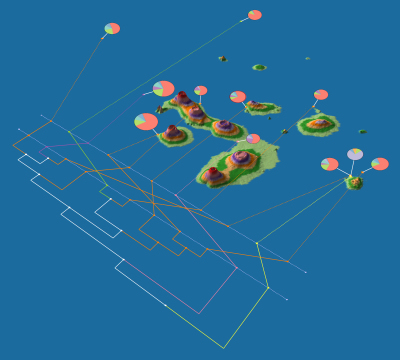Difference between revisions of "Main Page"
From Bioinformatics Software
Jump to navigationJump to search| Line 6: | Line 6: | ||
== Software (Currently Supported) == | == Software (Currently Supported) == | ||
Key: P = phylogenetics, S = statistics, B = biogeography, V = visualization, G = genomics, M = metagenomics, L = lateral genetic transfer, A = sequence alignment | Key: P = phylogenetics, S = statistics, B = biogeography, V = visualization, G = genomics, M = metagenomics, L = lateral genetic transfer, A = sequence alignment | ||
| − | |||
| − | |||
* [[ExpressBetaDiversity | Express Beta Diversity (EBD)]]: taxon- and phylogenetic-based beta diversity measures. (P) | * [[ExpressBetaDiversity | Express Beta Diversity (EBD)]]: taxon- and phylogenetic-based beta diversity measures. (P) | ||
| Line 16: | Line 14: | ||
* [[NetworkDiversity| Network Diversity]]: calculation of beta diversity over phylogenetic networks. (P) | * [[NetworkDiversity| Network Diversity]]: calculation of beta diversity over phylogenetic networks. (P) | ||
| − | |||
| − | |||
* [http://kiwi.cs.dal.ca/Software/rSPR rSPR]: software to calculate rooted subtree-prune-and-regraft distances and rooted agreement forests. (PL) | * [http://kiwi.cs.dal.ca/Software/rSPR rSPR]: software to calculate rooted subtree-prune-and-regraft distances and rooted agreement forests. (PL) | ||
| Line 34: | Line 30: | ||
* [http://bioinformatics.org.au/eeep/ EEEP (Efficient Evaluation of Edit Paths)]: software to infer putative pathways of lateral genetic transfer by comparing gene trees against a rooted reference tree (PL) | * [http://bioinformatics.org.au/eeep/ EEEP (Efficient Evaluation of Edit Paths)]: software to infer putative pathways of lateral genetic transfer by comparing gene trees against a rooted reference tree (PL) | ||
| + | |||
| + | * [http://bioinformatics.org.au/evolsim/ EvolSimulator]: a simulation test bed for hypotheses of genome evolution. (PL) | ||
| + | |||
| + | * [[RITA]]: Rapid Identification of Taxonomic Assignments for metagenomic fragments (M). | ||
* [[PICA]]: genotype-phenotype data mining software (G). | * [[PICA]]: genotype-phenotype data mining software (G). | ||
Revision as of 15:54, 1 May 2015
Welcome to the Bioinformatics Software and Resources page.
Software (Currently Supported)
Key: P = phylogenetics, S = statistics, B = biogeography, V = visualization, G = genomics, M = metagenomics, L = lateral genetic transfer, A = sequence alignment
- Express Beta Diversity (EBD): taxon- and phylogenetic-based beta diversity measures. (P)
- Fragment classification package (FCP): Homology- and composition-based classifiers for assigning a taxonomic attribution to metagenomic fragments. (GML)
- GenGIS: an application that allows users to combine digital map data with information about biological sequences collected from the environment. GenGIS provides a 3D graphical interface in which the user can navigate and explore the data, as well as a Python interface that allows easy scripting of statistical analyses using the Rpy libraries. (PSBVM)
- Network Diversity: calculation of beta diversity over phylogenetic networks. (P)
- rSPR: software to calculate rooted subtree-prune-and-regraft distances and rooted agreement forests. (PL)
- SPANNER: Homology-based taxonomic classification of protein sequences. (GML)
- SPRSupertrees: software to calculate rooted supertrees that minimize the SPR distance. (PL)
- STAMP: a software package for analyzing metagenomic profiles that promotes ‘best practices’ in choosing appropriate statistical techniques and reporting results. (SMV)
Older Software
The following software packages have largely been superseded by others in the above list, or by software written by others. The software should still work, but we can no longer offer significant support for it.
- EEEP (Efficient Evaluation of Edit Paths): software to infer putative pathways of lateral genetic transfer by comparing gene trees against a rooted reference tree (PL)
- EvolSimulator: a simulation test bed for hypotheses of genome evolution. (PL)
- RITA: Rapid Identification of Taxonomic Assignments for metagenomic fragments (M).
- PICA: genotype-phenotype data mining software (G).
- Radié: a tool that allows characters to be visualized against the background of a phylogenetic tree. The software includes several different visual and numeric representations of the ‘convexity’ of a given character, in other words the extent to which different character traits form distinct groups within the tree. (PV)
- GANN: a machine learning method designed with the complexities of transcriptional regulation in mind.
- WOOF: a tool designed to rigourously apply the principle of visual alignment validation. (SA)
Mailing list
- Join our mailing list to keep informed about new developments.
Datasets
- Datasets used in GenGIS (Parks et al., Genome Research 2009)
- STAMP datasets
- Lateral genetic transfer in 144 genomes dataset (Beiko et al., Proc. Natl. Acad. Sci. 2005)
- Simulated data for 'The impact of reticulate evolution on genome phylogeny' (Beiko et al., Systematic Biology 2008) [to be added]
Contributors
- Robert Beiko
- Christian Blouin
- Donovan Parks
- Chris Whidden
- Norman MacDonald
